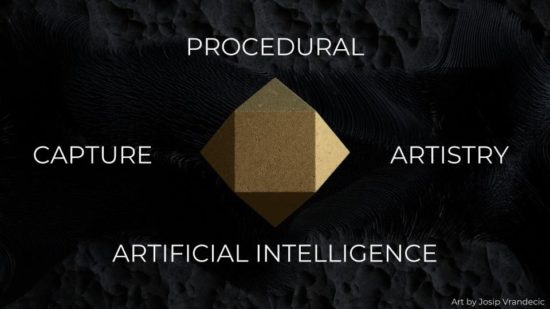Allegorithmic has been throwing itself parties all around the world to show off its capabilities, to teach users new tricks, and to preview upcoming software. Allegorithmic, with the help of industry partners, is defining new territory for content creation.

https://www.artstation.com/jonathan_benainous)
Founded by Sebastien Deguy in 2003, the company has been funded by the French government as part of its BPI Excellence Fund. The company was founded by Deguy to capitalize on and expand the work he did for his PhD thesis: “The tdMap Model: a partially identifiable complex medium generator.” The company’s expertise is founded on procedural methods for creating textures and materials. Allegorithmic introduced its tools first for the game industry because procedural textures don’t require gobs of memory, just processing cycles. As GPU processing power scales up, procedural content becomes more practical. Over the years, procedural methods have mostly replaced hand-made textures created by Photoshop artists in the game industry.
Allegorithmic’s next big turn of the wheel came in 2017 when they introduced Substance Designer 6, which enables scans to be used as tileable materials, but that was just the beginning of the company’s larger ambition, and work has continued to make scans part of a procedural workflow. At Siggraph in Vancouver, Allegorithmic showed the latest results of its ongoing work with an in-depth demo of its new Alchemist software, which will further the company’s dominance in the creation of materials, textures, and more.

Somewhat unhelpfully, the company says Alchemist “introduces new ways of creating, managing and processing materials. It allows mixing procedural-based, hand-made, capture-based and AI-based workflows.” Much more helpful is the video the company made for Substance Day at Siggraph 2018, which includes a detailed demo of Alchemist. Also, artist Josip Vrandecic explains his workflow using Alchemist to create a promo video for Allegorithmic. Alchemist enables artists to combine scans, procedural content, art, and push it all a little further with AI.
Alchemist has several important new features. The flashiest capabilities include:
- the ability to make scans more editable and scalable as procedural content,
- the ability to use sampled content such as photographs, ads, etc., to affect textures
- content management features which enable users to collect and organize all their Substance materials in collections, libraries, presets together with controls so it’s easy to understand how they were created and work.
The company is quickly growing beyond its early roots in game development and the company expects Alchemist to take them even further into new markets. At Siggraph, Deguy says the company’s fastest growing new market is in VFX, but it is also having new customers come to them from industrial design, AEC, marketing, etc. The company has important partners in Nvidia, Adobe, and HP (see the HP Sprout story this issue) to name a few. These partnerships and many others are helping redefine content creation and it’s putting the tools back in the hands of artists. Nvidia Iray is provided in Substance Painter and Substance Designer as an alternative viewport for ray tracing capabilities, while the primary realtime viewport is Allegorithmic’s own brew. Allegorithmic sees scanline and ray tracing techniques being more and more complementarily used according to specific needs. It is not about one winning against the other, but about how to build the most seamless workflow using the best of each world.
What do we think?
Several interesting things are happening in content creation industry and Allegorithmic is right there in the middle of it. There has been a long desire to use scanned images and captured colors to create realistic materials for industrial use. A lot of work had been done on that front in Germany by Realtime Technology, a company acquired by Dassault in 2014. The acquisition of RTT left a gap that Allegorithmic has handily filled with Substance Designer and Substance Alchemist will take it further. The company has been working on defining textiles for the sports industry and has introduced a line of Substance materials for the sportswear industry. In addition, the company has a user story based on its sportswear textiles for athletic shoes.
Adobe has signed on with Allegorithmic for Substance materials to enrich its Dimension CC tool, which allows 2D and 3D content to be combined to create marketing, visualization, and AR content. Dimension is a tool, which promises to have many applications because of its easy to use workflow.
Allegorithmic has many such relationships—enabling its textures to become ubiquitous in some markets and the company is aiming for more.
Allegorithmic is riding a trend with PBR and photogrammetry, which is fundamentally changing the content creation market. Imagine content creation pipelines devoid of modeling. Disney has been pushing PBR as new basis for content creation.
In the meantime, models for free, sale, or trade are adding to a giant worldwide library of content that can be used by creative people in marketing, 3D printing, AEC, and industrial design.





